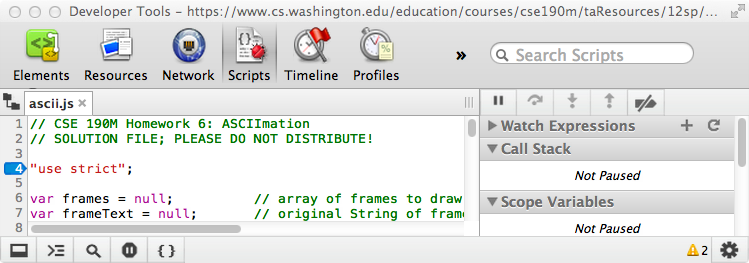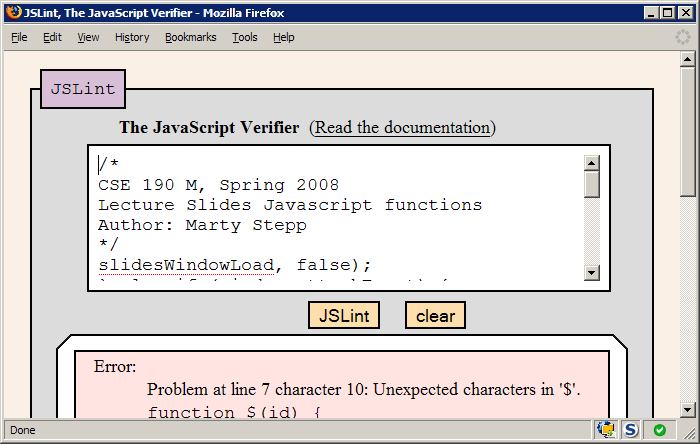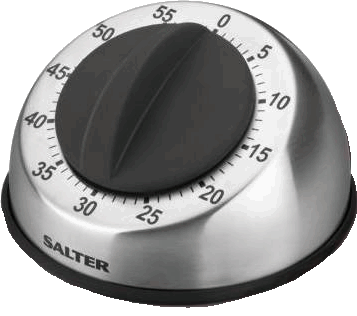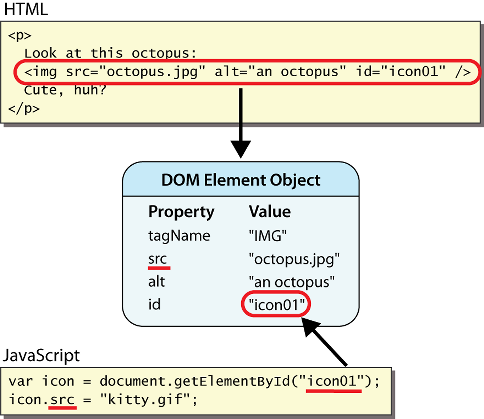CSE 190M Web Programming
Lecture 14: The Document Object Model (DOM); Timers
Reading: 8.2; 9.2; 11.1
Except where otherwise noted, the contents of this document are Copyright 2012 Marty Stepp, Jessica Miller, Victoria Kirst and Roy McElmurry IV. All rights reserved. Any redistribution, reproduction, transmission, or storage of part or all of the contents in any form is prohibited without the author's expressed written permission.
8.2.6: Debugging Common Errors
- 8.1: Key JavaScript Concepts
- 8.2: JavaScript Syntax
- 8.3: Program Logic
- 8.4: Advanced JavaScript Syntax
Debugging JS code in Firebug

- Chrome JS debugger can set breakpoints, step through code, examine values (Script tab)
- interactive console for typing in arbitrary JS expressions (Console tab)
JSLint

- JSLint: an analyzer that checks your JS code, much like a compiler, and points out common errors
- Web Step By Step version (recommended)
- original version, by Douglas Crockford of Yahoo!
- when your JS code doesn't work, paste it into JSLint first to find many common problems
JavaScript "strict" mode

"use strict"; your code...
(function() {
"use strict";
your code...
})();
- writing
"use strict";at the very top of your JS file turns on strict syntax checking:- shows an error if you try to assign to an undeclared variable
- stops you from overwriting key JS system libraries
- forbids some unsafe or error-prone language features
- "use strict" also works inside of individual functions
- You should always turn on strict mode for your code in this class!
Events and Timers
-
11.1: Event-Handling
- 11.1.1 The Event Object
- 11.1.2 Mouse Events
- 11.1.3 Keyboard and Text Events
- 11.1.4 Form Events
- 11.1.5 Page Events
- 11.1.6 Timer Events
- 11.2: Case Study: Multiplication Quiz
Timer events

| method | description |
|---|---|
setTimeout(function, delayMS);
|
arranges to call given function after given delay in ms |
setInterval(function, delayMS);
|
arranges to call function repeatedly every delayMS ms |
clearTimeout(timerID); clearInterval(timerID);
|
stops the given timer so it will not call its function |
-
both
setTimeoutandsetIntervalreturn an ID representing the timer-
this ID can be passed to
clearTimeout/Intervallater to stop the timer
-
this ID can be passed to
setTimeout example
<button onclick="delayMsg();">Click me!</button> <span id="output"></span>
function delayMsg() {
setTimeout(booyah, 5000);
document.getElementById("output").innerHTML = "Wait for it...";
}
function booyah() { // called when the timer goes off
document.getElementById("output").innerHTML = "BOOYAH!";
}
setInterval example
var timer = null; // stores ID of interval timer function delayMsg2() { if (timer == null) { timer = setInterval(rudy, 1000); } else { clearInterval(timer); timer = null; } } function rudy() { // called each time the timer goes off document.getElementById("output").innerHTML += " Rudy!"; }
Exercise: Alarm Clock page
We want to add javascript to this alarm page.
- Write javascript code to decrement the time until zero and then print an alert.
- The clock should start when the button is clicked.
- The clock should stop when the time reaches zero.
- The button should not do anyithng if the alarm is already running.
Passing parameters to timers
function delayedMultiply() {
// 6 and 7 are passed to multiply when timer goes off
setTimeout(multiply, 2000, 6, 7);
}
function multiply(a, b) {
alert(a * b);
}
- any parameters after the delay are eventually passed to the timer function
- doesn't work in IE6; must create an intermediate function to pass the parameters
-
why not just write this?
setTimeout(multiply(6 * 7), 2000);
Common timer errors
-
many students mistakenly write
()when passing the functionsetTimeout(booyah(), 2000);setTimeout(booyah, 2000);setTimeout(multiply(num1 * num2), 2000);setTimeout(multiply, 2000, num1, num2);- what does it actually do if you have the
()? - it calls the function immediately, rather than waiting the 2000ms!
- what does it actually do if you have the
9.2: DOM Element Objects
- 9.1: Global DOM Objects
- 9.2: DOM Element Objects
- 9.3: The DOM Tree
DOM element objects

- every element on the page has a corresponding DOM object
-
access/modify the attributes of the DOM object with
objectName.attributeName
DOM object properties
<div id="main" class="foo bar"> <p>Hello, <em>very</em> happy to see you!</p> <img id="icon" src="images/borat.jpg" alt="Borat" /> </div>
var mainDiv = document.getElementById("main");
var icon = document.getElementById("icon");
| Property | Description | Example |
|---|---|---|
tagName
|
element's HTML tag |
mainDiv.tagName is "DIV"
|
className
|
CSS classes of element |
mainDiv.className is "foo bar"
|
innerHTML
|
content in element |
mainDiv.innerHTML is "\n <p>Hello, <em>ve...
|
src
|
URL target of an image |
icon.src is "images/borat.jpg"
|
DOM properties for form controls
<input id="sid" type="text" size="7" maxlength="7" /> <input id="frosh" type="checkbox" checked="checked" /> Freshman?
var sid = document.getElementById("sid");
var frosh = document.getElementById("frosh");
| Property | Description | Example |
|---|---|---|
value
|
the text/value chosen by the user |
sid.value could be "1234567"
|
checked
|
whether a box is checked |
frosh.checked is true
|
disabled
|
whether a control is disabled (boolean) |
frosh.disabled is false
|
readOnly
|
whether a text box is read-only |
sid.readOnly is false
|
More about form controls
<select id="captain"> <option value="kirk">James T. Kirk</option> <option value="picard">Jean-Luc Picard</option> <option value="cisco">Benjamin Cisco</option> </select> <label> <input id="trekkie" type="checkbox" /> I'm a Trekkie </label>
- when talking to a text box or
select, you usually want itsvalue - when talking to a checkbox or radio button, you probably want to know if it's
checked(true/false)
Abuse of innerHTML
// bad style!
var paragraph = document.getElementById("welcome");
paragraph.innerHTML = "<p>text and <a href="page.html">link</a>";
innerHTMLcan inject arbitrary HTML content into the page- however, this is prone to bugs and errors and is considered poor style
- we forbid using
innerHTMLto inject HTML tags; inject plain text only- (later, we'll see a better way to inject content with HTML tags in it)
Adjusting styles with the DOM
<button id="clickme">Color Me</button>
window.onload = function() {
document.getElementById("clickme").onclick = changeColor;
};
function changeColor() {
var clickMe = document.getElementById("clickme");
clickMe.style.color = "red";
}
| Property | Description |
|---|---|
style
|
lets you set any CSS style property for an element |
- contains same properties as in CSS, but with
camelCasedNames- examples:
backgroundColor,borderLeftWidth,fontFamily
- examples:
Common DOM styling errors
- many students forget to write
.stylewhen setting stylesvar clickMe = document.getElementById("clickme");clickMe.color = "red";clickMe.style.color = "red"; - style properties are capitalized
likeThis, notlike-thisclickMe.style.font-size = "14pt";clickMe.style.fontSize = "14pt"; - style properties must be set as strings, often with units at the end
clickMe.style.width = 200;clickMe.style.width = "200px"; clickMe.style.padding = "0.5em";- write exactly the value you would have written in the CSS, but in quotes
Unobtrusive styling
function okayClick() {
this.style.color = "red";
this.className = "highlighted";
}
.highlighted { color: red; }
- well-written JavaScript code should contain as little CSS as possible
- use JS to set CSS classes/IDs on elements
- define the styles of those classes/IDs in your CSS file
Getting/setting CSS classes
function highlightField() {
// turn text yellow and make it bigger
if (!document.getElementById("text").className) {
document.getElementById("text").className = "highlight";
} else if (document.getElementById("text").className.indexOf("invalid") < 0) {
document.getElementById("text").className += " highlight";
}
}
- JS DOM's
classNameproperty corresponds to HTMLclassattribute - somewhat clunky when dealing with multiple space-separated classes as one big string
Problems with reading/changing styles
<button id="clickme">Click Me</button>
window.onload = function() {
document.getElementById("clickme").onclick = biggerFont;
};
function biggerFont() {
var size = parseInt(document.getElementById("clickme").style.fontSize);
size += 4;
document.getElementById("clickMe").style.fontSize = size + "pt";
}
styleproperty lets you set any CSS style for an element- problem: you cannot (usually) read existing styles with it
Common bug: incorrect usage of existing styles
document.getElementById("main").style.top = document.getElementById("main").style.top + 100 + "px";// bad!
- the above example computes e.g.
"200px" + 100 + "px",
which would evaluate to"200px100px" -
a corrected version:
document.getElementById("main").style.top = parseInt(document.getElementById("main").style.top) + 100 + "px"; // correct
9.1: Global DOM Objects
- 9.1: Global DOM Objects
- 9.2: DOM Element Objects
- 9.3: The DOM Tree
The six global DOM objects
Every Javascript program can refer to the following global objects:
| name | description |
|---|---|
document
|
current HTML page and its content |
history
|
list of pages the user has visited |
location
|
URL of the current HTML page |
navigator
|
info about the web browser you are using |
screen
|
info about the screen area occupied by the browser |
window
|
the browser window |
The window object
the entire browser window; the top-level object in DOM hierarchy
- technically, all global code and variables become part of the
windowobject - properties:
- methods:
-
alert,confirm,prompt(popup boxes) -
setInterval,setTimeoutclearInterval,clearTimeout(timers) -
open,close(popping up new browser windows) -
blur,focus,moveBy,moveTo,print,resizeBy,resizeTo,scrollBy,scrollTo
-
Popup windows with window.open
window.open("http://foo.com/bar.html", "My Foo Window",
"width=900,height=600,scrollbars=1");
window.openpops up a new browser window- THIS method is the cause of all the terrible popups on the web!
- some popup blocker software will prevent this method from running
The document object
the current web page and the elements inside it
- properties:
- methods:
- complete list
The location object
the URL of the current web page
The navigator object
information about the web browser application
- properties:
-
Some web programmers examine the
navigatorobject to see what browser is being used, and write browser-specific scripts and hacks:if (navigator.appName === "Microsoft Internet Explorer") { ...- (this is poor style; you should not need to do this)

